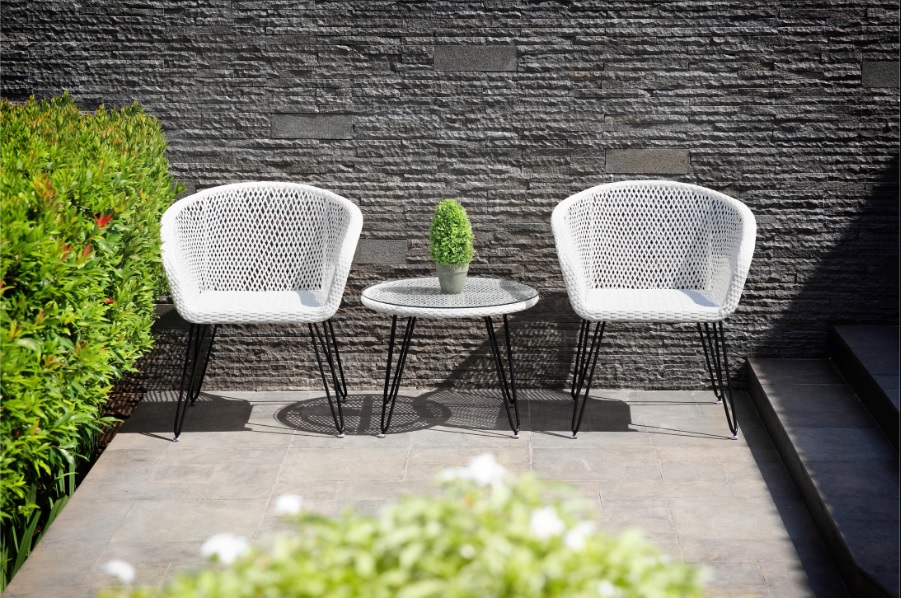Introduction: A New Era of Outdoor Living
Outdoor garden furniture has experienced a major transformation over the decades—from the classic wrought iron chairs of the early 1900s to today’s sophisticated, weather-resistant collections made from synthetic rattan and rope. This shift reflects not only design preferences but also broader trends in climate adaptation, sustainability, and the rise of outdoor-centric lifestyles. The growing desire to blend functionality, luxury, and durability in outdoor spaces has driven the rise of these innovative materials.
The global demand for low-maintenance yet stylish furniture for patios, gardens, terraces, and poolside areas has fueled experimentation with synthetic materials. Among the top contenders, synthetic rattan and synthetic rope have emerged as front-runners, prized for their resilience, aesthetic flexibility, and eco-conscious appeal.
From Natural to Synthetic: A Historical Glimpse
Rattan, a climbing palm native to Southeast Asia, has long been used in traditional furniture making. It offered flexibility, strength, and a naturally rustic appeal. Yet as beautiful as it was, natural rattan came with limitations: it could crack under prolonged exposure to moisture, fade under UV rays, and warp in fluctuating temperatures.
As outdoor living grew more mainstream—especially in Europe and the U.S. in the post-World War II era—consumers sought materials that could endure changing seasons. This led to the emergence of synthetic rattan, developed using polyethylene (PE), HDPE (high-density polyethylene), or resin-based materials that mimicked the look of natural rattan while significantly enhancing its durability.
Meanwhile, synthetic rope, made from polypropylene or polyester, entered the scene as a sleek, modern material offering not only a visually striking texture but also extraordinary resilience against outdoor elements.
Together, these materials revolutionized garden furniture design.
Climate Resilience: Why Synthetic Wins
In an era increasingly shaped by climate volatility—stronger UV rays, torrential rains, rising humidity levels—natural materials often fall short in longevity. Synthetic rattan and rope, however, are engineered to endure. Unlike their organic counterparts, they don’t absorb water, crack, or lose color quickly.
This climate adaptability is crucial. In tropical countries like Indonesia, Malaysia, and Thailand, outdoor furniture must handle heavy monsoon rains and scorching heat. In Europe and North America, it must resist snow, frost, and intense summer sun. Synthetic rattan and rope tick every box, offering all-season performance.
In addition, manufacturers have innovated UV stabilizers in the resin mix of synthetic rattan and incorporated water-resistant coatings in synthetic rope, making these materials even more reliable for long-term outdoor exposure.
Sustainability: Navigating the Eco Paradox
One of the biggest concerns of the 21st century is sustainability. Consumers now ask: Is synthetic furniture truly sustainable? After all, it’s derived from plastic-based components.
Here lies a paradox. While synthetic rattan and rope are indeed plastic derivatives, many manufacturers now use recycled polyethylene, which minimizes reliance on virgin plastics. Furthermore, the incredible durability of these materials ensures products last for decades—not just seasons—reducing landfill waste and the need for constant replacements.
Synthetic materials also reduce pressure on natural rattan harvesting, which, when done irresponsibly, can contribute to deforestation and biodiversity loss. By using alternatives, manufacturers indirectly support forest conservation.
In Europe, certifications such as REACH compliance and in Indonesia, SVLK legality and FSC-controlled wood frames, further assure buyers that production meets global environmental standards.
Design Innovation: From Rustic to Minimalist Chic
Synthetic rattan furniture has come a long way from its rustic roots. While it originally tried to mimic the woven look of natural rattan, today’s designs have evolved into minimalist, contemporary forms. Wide weaves, intricate lattice patterns, and modular structures are now possible thanks to synthetic materials that offer precision and consistency in weaving.
Synthetic rope, in contrast, leans toward modern luxury. It allows for sleek designs with a more tailored aesthetic—perfect for urban terraces or contemporary gardens. The rope can be woven in vertical, diagonal, or even braided forms, creating captivating patterns that are impossible with traditional rattan.
The ability to pair these synthetic materials with other elements like teak wood, powder-coated aluminum, or tempered glass has opened up limitless design possibilities. Whether your garden leans boho, coastal, Scandinavian, or industrial, synthetic furniture adapts beautifully.
Indoor-Outdoors: The Blurring of Spaces
One of the most significant design movements in recent years is the blurring of indoor and outdoor spaces. More homeowners and architects are now treating patios, balconies, and gardens as extensions of the living room. This means outdoor furniture must no longer look “functional” alone—it must feel inviting, plush, and cohesive with indoor décor.
Synthetic rattan and rope play a vital role in this transition. Their soft finishes, versatile colors, and ability to pair with high-quality cushions allow designers to create seamless visual flows between inside and out.
Today’s consumers demand sectional sofas, daybeds, and dining sets that can grace both a sun-soaked deck and a cozy lounge area. The adaptability of these materials ensures they meet such expectations effortlessly.
Global Trend Drivers: Pandemic, Social Media, and Remote Work
Three major factors have accelerated the demand for premium outdoor furniture worldwide: the COVID-19 pandemic, the rise of social media aesthetics, and the increase in remote work culture.
During the pandemic, people began investing more in their homes, especially their gardens and patios. These outdoor areas became safe havens for relaxation and family bonding. Consequently, demand for stylish, durable garden furniture surged.
Platforms like Instagram and Pinterest played a crucial role too. They turned outdoor styling into a visual art form. Trending hashtags like #outdoorliving, #balconymakeover, and #gardenretreat sparked global interest in aesthetic, functional outdoor spaces.
Meanwhile, with more people working from home, outdoor spaces became informal offices. Comfortable seating made from synthetic materials, with ergonomic features, weather resistance, and light weight, made them a perfect fit for this new lifestyle.
Low Maintenance: Time-Saving and Cost-Efficient
Another key advantage of synthetic rattan and rope furniture is its low maintenance. Unlike wood, which requires regular oiling or varnishing, synthetic furniture only needs occasional cleaning with water and mild soap. It resists mold, mildew, pests, and sun damage without the need for chemicals or elaborate care routines.
This ease of upkeep is especially appreciated by commercial clients—hotels, resorts, restaurants, and cafes—who need furniture that stays pristine with minimal labor. Likewise, residential users are drawn to the idea of “set and forget” garden furniture.
Manufacturing Excellence: The Role of Indonesia and Asia
Indonesia, China, and Vietnam are among the global leaders in producing synthetic rattan and rope furniture. Indonesia, in particular, stands out not just for its craftsmanship but for its combination of traditional weaving skills with modern materials.
Factories in regions like Cirebon and Solo have mastered the balance between handmade artistry and large-scale production, ensuring furniture that is both high quality and visually unique. Many manufacturers in Indonesia also hold international certifications such as BSCI (Business Social Compliance Initiative), FSC, and SVLK, which assure buyers of ethical labor practices and environmental responsibility.
Furthermore, Indonesia offers the added advantage of customization. Global B2B buyers can request specific color palettes, weave styles, or frame materials, making it a prime destination for private label and contract furniture projects.
Common Myths and Misconceptions
Despite its popularity, synthetic outdoor furniture still faces a few lingering myths. One common belief is that synthetic equals cheap or low-quality. This couldn’t be further from the truth. In fact, some of the world’s leading furniture brands—luxury included—now exclusively use synthetic rattan and rope for their outdoor collections because of the superior performance and style they provide.
Another myth is that synthetic rope will sag or lose elasticity. In reality, high-quality rope used in furniture is engineered with anti-stretch properties and UV-resistant fibers, maintaining its form for years.
Also, many worry that synthetic furniture looks too artificial. However, advanced texturing techniques now produce materials that are nearly indistinguishable from natural ones, both in appearance and touch.
Future Outlook: What’s Next?
The outdoor furniture industry is set to experience even more innovation. Manufacturers are now exploring biodegradable synthetic fibers, plant-based plastics, and even solar-integrated furniture that can charge your devices while you relax in the garden.
At the same time, personalization is becoming a major trend. More customers now seek bespoke designs—custom sizes, colors, and fabric types that reflect their individual taste or brand identity. Artificial intelligence is also entering the scene, helping manufacturers predict trends and design patterns based on consumer data.
With the growing adoption of eco-certifications and digital supply chains, the future of synthetic outdoor furniture looks bright—and sustainable.
Conclusion: The Smart Choice for Modern Outdoor Living
Synthetic rattan and rope furniture represent the perfect fusion of durability, beauty, and modern lifestyle demands. As people continue to invest in outdoor spaces for relaxation, work, and socialization, these materials offer unmatched advantages.
They are not only weatherproof and stylish but also environmentally conscious when sourced responsibly. Their evolution—from early plastic imitations to today’s high-performance fibers—reflects how far the furniture industry has come in meeting the needs of a changing world.
Whether you’re a resort planner, a garden design enthusiast, a homeowner, or a global furniture buyer, choosing outdoor furniture made from synthetic rattan or rope is not just a trend—it’s a statement of comfort, resilience, and forward-thinking design.

